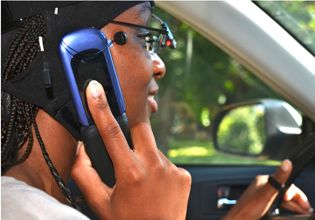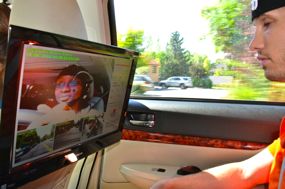Citing “a looming public safety crisis” from in-vehicle communications technologies, AAA released a study that again concludes hands-free is not risk free.
“Just because a new technology does not take the eyes off the road does not make it safe,” said the report from David Strayer’s team at the University of Utah.
 AAA predicts a “five-fold increase in infotainment systems in new vehicles by 2018.”
AAA predicts a “five-fold increase in infotainment systems in new vehicles by 2018.”
“A rush to voice-based interactions in the vehicle may have unintended consequences that adversely affect vehicle safety,” the researchers concluded.
The report came a day after Apple cited widespread automaker adoption of its expanded Siri hands-free features.
The Utah team found that compared with other activities such as listening to the radio and talking with passengers, interacting with a speech-to-text system was the most cognitively distracting.
“An unintended consequence of trying to make driving safer — by moving to speech-to-text in-vehicle systems — may actually overload the driver and make them less safe,” Strayer said.
Sponsor AAA said the Utah lab report was the “most comprehensive study of its kind to look at the mental distraction of drivers.” The auto organization planned to “appeal to the public to not use these voice-to-text features while their vehicle is in motion.”
AAA president Robert Darbelnet said:
There is a looming public safety crisis ahead with the future proliferation of these in-vehicle technologies. It’s time to consider limiting new and potentially dangerous mental distractions built into cars, particularly with the common public misperception that hands-free means risk-free.
AAA said it provided copies of the report to chief executives of all major U.S. automakers.
The trade group the Consumer Electronics Association said the AAA study “suffers from a number of methodology flaws” and “its broad conclusions about voice-to-text technology should be questioned.” (The CEA puts on the CES event in Las Vegas, which has been used to unveil several interactive vehicle dashboard systems.)
 The sample group in the Utah study was relatively small and limited to college-age drivers who were familiar with cell phone operation. Their brainwaves, reaction times, and head and eye movements were examined as they performed multiple tasks while driving. Researchers used a driving similator in a lab as well as an instrumented test vehicle on nearby streets (pictured, above and right).
The sample group in the Utah study was relatively small and limited to college-age drivers who were familiar with cell phone operation. Their brainwaves, reaction times, and head and eye movements were examined as they performed multiple tasks while driving. Researchers used a driving similator in a lab as well as an instrumented test vehicle on nearby streets (pictured, above and right).
Researchers rated the levels of mental distraction drivers experienced while performing each of the tasks, on a scale of 1 to 3. They found that talking on a cell phone (handheld or hands-free) ranked a 2 on the distraction scale, but that listening and responding to in-vehicle voice-activated email features resulted in “extensive risk” at level 3. (Listening to a radio was level 1.)
More than a year ago, the National Highway Traffic Safety Administration issued voluntary guidelines encouraging automobile manufacturers to limit the distraction risk for in-vehicle electronic devices.
The NHTSA tread carefully on the issue, with administrator David Strickland labeling the proposals as “real-world guidance to automakers to help them develop electronic devices that provide features consumers want — without disrupting a driver’s attention or sacrificing safety.”
Similarly, the AAA urged “the automotive and electronics industries to join us in exploring” ways to cut the distractions in vehicle infotainment systems.
These suggestions included disabling social media access and text messaging while a vehicle is in motion.
“Just because you can update Facebook while driving doesn’t mean that it is safe to do so,” Strayer said. “Don’t assume that if your eyes are on the road and your hands are on the wheel that you are unimpaired.”
Automaker lobbyists have been successful in having some distracted driving laws and proposed laws amended to exempt their hands-free in-dash systems from regulation.
“These increasingly common voice-driven in-vehicle technologies should be limited to use for just core driving tasks unless the activity results in no significant driver distraction,” AAA’s Darbelnet said.
Strayer is known for his widely cited findings that distracted drivers are as dangerous as drunken drivers, and that hands-free cell phone use is no safer than handheld cell phone use while driving.
Automaker BMW said last week that it is putting Apple’s Siri Eyes Free in its 2014 models. The expanded iOS in the Car system has support from Honda, Mercedes, Nisson, Infiniti and Volvo, among others, Apple said June 12. Chevy was the first automaker to bring Siri Eyes Free integration to market.
Read the report “Measuring Cognitive Distraction in the Automobile” (PDF)


This info is not new. This is just the latest survey that proves hands-free is as dangerous as hand-held. The conversation is the distraction. The politicians know this yet they ignore it. I predict they will ignore this study too. Safety is not their main concern. Revenue enhancement and re-election trump all else.